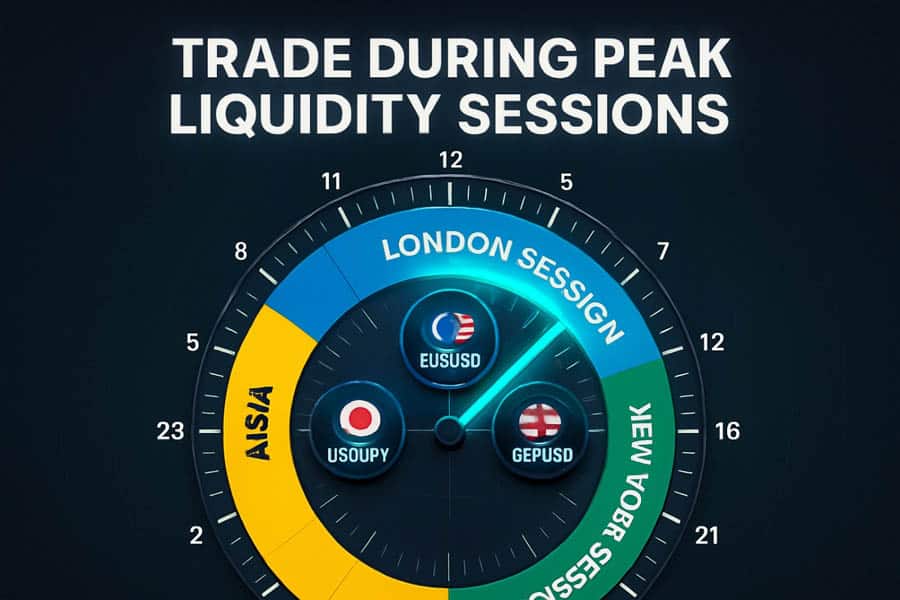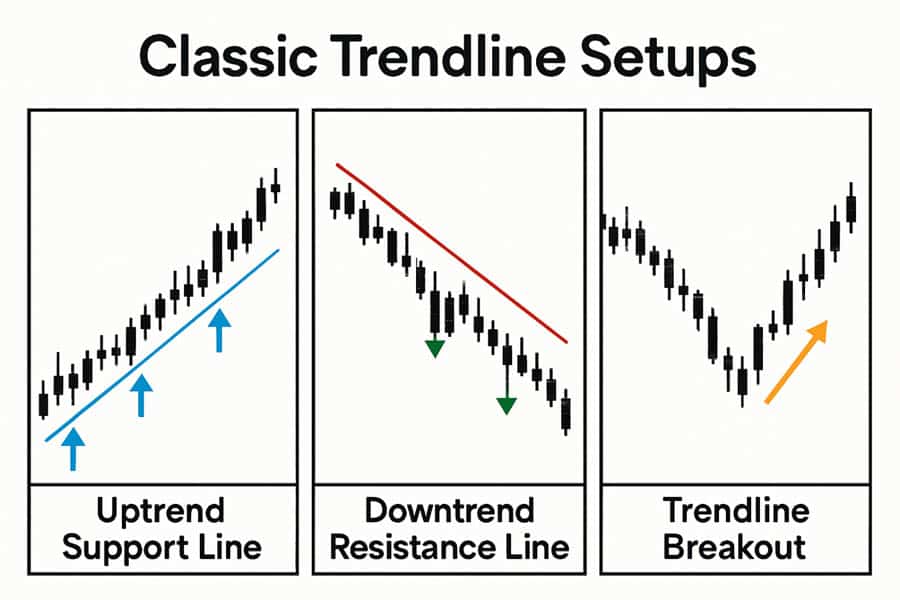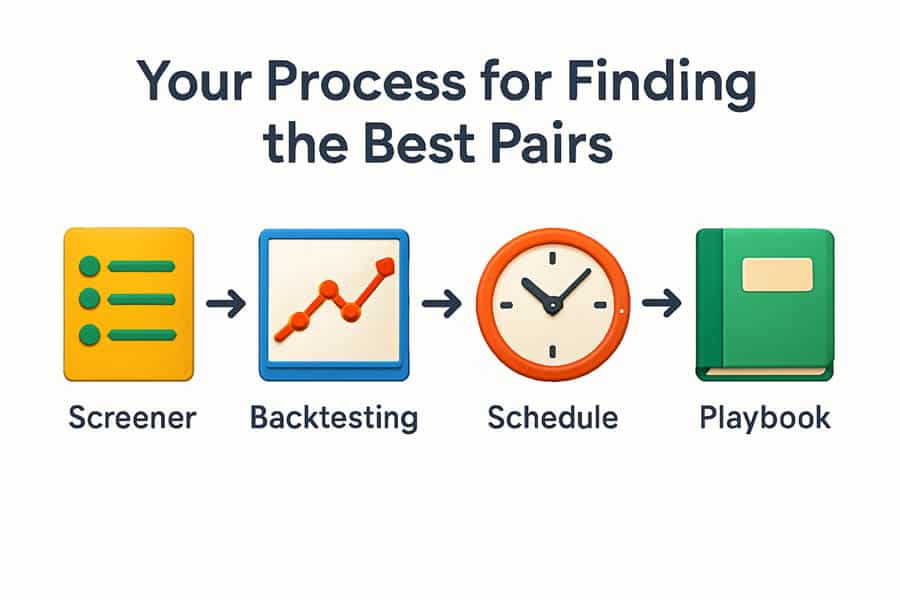Finding the best pairs for trendline trading is the cornerstone of a successful strategy. The key lies in identifying currencies that exhibit strong, sustained directional moves and respect technical boundaries. This guide reveals the most reliable major and cross pairs, including EUR/USD, GBP/USD, and USD/JPY, which consistently offer high-probability trendline setups. We will explore the precise conditions and time windows where these pairs excel, providing you with actionable, experience-based playbooks to elevate your trading. With a trusted forex broker, you can effectively apply these strategies across the best currency pairs for trend trading.

Quick Summary of Top Pairs for Trend Trading
For traders who need a quick reference, the table below summarizes the best pairs for various trend trading styles and conditions. Each of these will be explored in depth throughout the article.
| Category | Currency Pair(s) |
|---|---|
| Best Overall Daily Trend (50MA Persistence) | EUR/USD, GBP/USD, USD/JPY |
| Highest Momentum/Volatility for Breaks | NZD/USD, GBP/JPY, AUD/USD |
| Most Liquid (Tightest Spreads) | EUR/USD, USD/JPY, GBP/USD, AUD/USD, USD/CHF, USD/CAD |
| Best for Long-Term Weekly Trends | USD/JPY, USD/CAD, GBP/USD |
| Cleanest Structure (Fewer Spikes) | NZD/USD |
| Best Crosses for Powerful Trend Bursts | GBP/JPY, EUR/JPY |
What Defines the Best Pair for Trend Trading?
The concept of a “best” pair is not universal; it’s specific to your strategy, schedule, and risk tolerance. For a trendline trader, the ideal pair isn’t just the most traded one. It’s a pair whose personality aligns with your technical approach. The best pairs for trendline trading share a few key characteristics: they trend persistently, offer enough volatility for meaningful price moves, and respect technical structures without excessive, unpredictable spikes. Understanding these traits is the first step to building a reliable trading plan.
Best Market Times for Trend Trading

A pair’s behavior is fundamentally tied to its active trading session. Trading a pair during its peak liquidity hours dramatically increases the probability of clean, sustained moves and reduces the risk of false signals. Aligning your strategy with these windows is non-negotiable.
- London Session (Open to Close): This is the epicenter of global forex liquidity. For pairs like EUR/USD, GBP/USD, and their crosses (EUR/GBP, GBP/JPY), this session offers the highest volume, tightest spreads, and cleanest reactions to trendlines. The early hours (08:00-10:00 GMT) are particularly potent for establishing the day’s directional bias.
- London–New York Overlap: For about four hours, the two largest financial centers are open simultaneously. This period sees the strongest momentum and is ideal for trading breakout and continuation patterns on all USD major pairs. If you’re looking for decisive breaks of established trendlines, this is your prime time.
- Asian Session: While quieter, the Asian session offers its own distinct advantages. It’s the best time for smoother, less volatile trending conditions on pairs like USD/JPY and AUD/JPY. Trendlines often form clean, stair-step patterns, providing excellent opportunities for bounce strategies without the noise of the London or New York sessions.
Criteria for Trend Trading Setups

Beyond timing, we must analyze a pair’s statistical behavior. These metrics help us objectively identify the best forex pairs for trend trading, moving beyond opinion and into data-driven decisions.
- Trend Persistence: This is the ultimate measure. How long does a pair hold a trend? A simple but powerful way to measure this is by tracking the number of consecutive daily or weekly closes above or below a key moving average, like the 50-period MA. Pairs like EUR/USD, GBP/USD, and USD/JPY consistently lead in daily persistence, making them prime candidates.
- Volatility and Momentum: A trend is useless if it doesn’t move. We need pairs with a healthy Average True Range (ATR) to ensure that moves between trendline touches are significant enough to be profitable. High-momentum pairs like NZD/USD, GBP/JPY, and AUD/USD provide the explosive power needed for strong trendline rejections and decisive breakouts.
- Spikiness (Wick-to-Body Ratio): A “spiky” pair with long wicks can be a trendline trader’s nightmare, constantly triggering stops on false breakouts. We look for pairs with a lower median “spikiness”—meaning their candle bodies are substantial relative to their wicks. NZD/USD often exhibits this clean structure, while pairs like GBP/JPY can be notoriously spiky and require wider stops.
- Liquidity and Spread: Always a factor, liquidity ensures you get fair fills on your entries and exits. Trading the majors (EUR/USD, USD/JPY, GBP/USD, AUD/USD, USD/CHF, USD/CAD) guarantees tight spreads, which is crucial for protecting your capital, especially when using tight stops on trendline bounces.
A Quick Guide to Trendline Setups

Identifying the best pairs for trendline trading is only half the battle. You need a set of proven, repeatable setups to execute your strategy. These three classic patterns form the foundation of most successful trendline systems. The key is to match the setup to the pair’s personality and the current market conditions.
Classic Trendline Bounce
This is the bread-and-butter setup for trendline traders. The logic is simple: identify a valid trendline with at least two confirmed touches and enter on a rejection of the third touch. For this setup to work, you need confluence—additional factors that support your trade idea. Look for the third touch to coincide with a horizontal support/resistance level, a Fibonacci retracement level (like the 38.2% or 61.8%), or a moving average. The entry trigger is a strong rejection candle, such as a pin bar or an engulfing pattern. This setup thrives on pairs with moderate volatility and clean structure, like EUR/USD and NZD/USD.
Trendline Break and Retest
Sometimes, a trendline is destined to break. Instead of fighting it, the savvy trader waits for confirmation. The break-and-retest strategy involves waiting for a strong, full-body candle to close decisively beyond the trendline. This is the “break.” Then, you wait for price to pull back and “retest” the broken trendline from the other side. This retest zone is your entry point. Look for a rejection candle at the retest to confirm the trendline has flipped from support to resistance (or vice versa). This setup is most powerful on high-momentum pairs during liquid overlap sessions, making it ideal for GBP/JPY, AUD/USD, and USD/JPY.
Channel Continuation
When a pair is moving within two parallel trendlines, it forms a channel. This provides a clear roadmap for the trend’s path. The strategy here is to trade with the primary trend by entering on pullbacks to the lower trendline in an uptrend or the upper trendline in a downtrend. This allows you to join the trend at a value price. Look for pairs that exhibit steady, persistent moves, such as EUR/USD and GBP/USD during strong macro-driven trends. Aligning your entries with the 50-period moving average can add another layer of confirmation to this powerful continuation strategy.
How to Find Your Best Pair

The journey to finding your personal best pairs for trendline trading is an active, data-driven process. It involves moving from a general list to a specialized watchlist that fits you like a glove. This is about building mastery over a few select instruments rather than being a jack-of-all-trades.
Start with objective data. Use a forex screener or analytical tool to rank pairs based on the criteria we’ve discussed: trend persistence (consecutive closes past the 50 MA), average daily volatility (ATR), and median spikiness. Create a shortlist of 3-4 pairs that score well in the areas that match your preferred setup—be it clean bounces or high-momentum breaks.
Next, align this shortlist with your personal schedule. If you can only trade during the Asian session, your focus should be on JPY pairs. If you have time during the London-NY overlap, the USD majors are your prime candidates. Trading during a pair’s “prime time” is a non-negotiable rule for success.
With your shortlisted pairs, the real work begins: backtesting. Manually go back through at least 2-5 years of charts for each pair. Test your specific setups (e.g., third-touch bounce, break-and-retest) and meticulously log the results. Record the strike rate, the session, whether news was a factor, and the average risk-to-reward ratio. This process will reveal which pair’s rhythm truly syncs with your strategy.
Finally, consolidate this research into a “pair playbook.” For each of your chosen pairs, create a one-page document that defines its personality: its best trading hours, the trendline angles it respects most, its ideal ATR range for your setups, and a specific risk model (e.g., “For GBP/JPY breaks, use a 2x ATR stop; for EUR/USD bounces, use a 1.5x ATR stop”). This playbook becomes your trading bible, guiding your decisions with data, not emotion. Remember that market dynamics shift, so you should re-evaluate your pairs’ trendedness monthly to ensure your watchlist remains optimized.
Trader-Tested Trend Trading Blueprints by Pair
Theory is one thing; practical application is another. Here are detailed, experience-based playbooks for some of the best forex pairs for trend trading. These insights are drawn from thousands of hours of screen time and highlight the specific setups, timings, and cautions for each pair.
EUR/USD: The Steady Workhorse
- Why it works: It boasts top-tier daily trend persistence against the 50-period moving average. Its unparalleled liquidity means ultra-tight spreads, which significantly reduces the chance of being stopped out by a few pips on a clean trendline bounce. This is one of the most reliable and predictable pairs.
- Best times: The London open (08:00-10:00 GMT) is perfect for clean bounce setups as the session’s direction is established. The London-NY overlap (13:00-16:00 GMT) is when you’ll find the most powerful continuation and breakout moves, often driven by US economic data.
- Best setups: The classic third-touch trendline bounce with a strong rejection candle is highly reliable on this pair. Break-and-retest setups work exceptionally well around major news releases (like NFP or FOMC), but it’s wise to wait for the dust to settle. In strong macro trends, trading channel continuations is a low-stress way to compound gains.
- Cautions: Be extremely mindful of major news from both the ECB and the Fed. The price action can be incredibly choppy and erratic in the minutes surrounding these events. It’s often best to stay flat or use time-based filters to avoid the initial whipsaw.
GBP/USD: The Classic Mover
- Why it works: “Cable” offers a fantastic blend of strong daily trend persistence and higher volatility than its European counterpart. It carves out clean, sustained runs on both daily and weekly charts, often driven by clear fundamental shifts in UK or US economic data or overall risk sentiment.
- Best times: The early London session is prime time for bounce setups, as liquidity pours in and the pair finds its footing. For breakouts, the London-NY overlap provides the necessary volume and momentum to push through key levels.
- Best setups: The break-and-retest strategy is particularly effective on GBP/USD during the overlap session. Its decisive moves provide clear confirmation. Trendline bounces with confluence from significant horizontal zones are also a high-probability trade.
- Cautions: Its higher volatility is a double-edged sword. You must use wider stops than you would for EUR/USD. Always base your stop-loss on the pair’s current ATR to adapt to changing market conditions and avoid premature stop-outs.
USD/JPY: The Macro Trend Follower
- Why it works: This pair is a macro trader’s dream. Its trends are durable on both daily and weekly timeframes, often driven by long-term, slow-moving fundamentals like interest rate differentials between the US and Japan. This makes it one of the best currency pairs for trend trading over longer horizons.
- Best times: The Asian session provides smoother, cleaner price action, making it ideal for testing trendline bounce setups. For high-momentum breakout trades, the London-NY overlap is when US economic data can ignite powerful, directional moves.
- Best setups: Trendline breaks that are aligned with widening US-Japan yield spreads are among the highest-probability trades you can find. Classic trendline bounces during the Tokyo session flows are also very reliable. Its tendency to form clean, stair-stepping channels makes it great for continuation plays.
- Cautions: Be vigilant for headlines from the Bank of Japan (BOJ), as unexpected policy shifts can cause massive gaps and extreme volatility. It’s a pair that respects technicals until it suddenly doesn’t, usually due to central bank intervention.
NZD/USD: The Clean Momentum King
- Why it works: The “Kiwi” offers a unique and highly desirable combination: high momentum coupled with cleaner-than-average candle structures (a lower median spikiness). This means you get powerful moves with fewer false breakouts from long, erratic wicks, making it one of the best pairs for trendline trading from a structural purity standpoint.
- Best times: The London-NY overlap is when it’s most active, especially when driven by broad US dollar sentiment. The late Asia/early London window is also key, as it often reacts to shifts in commodity prices and overall risk-on/risk-off tone.
- Best setups: The third-touch trendline bounce with a powerful, clear rejection candle is a standout setup on NZD/USD. Its clean structure provides very clear entry signals. Break-and-retest plays that align with Fibonacci confluence zones are also extremely effective.
- Cautions: As a commodity currency, it can be sensitive to sudden shocks in global growth data or dairy prices. Always manage risk with an ATR-based stop to account for its inherent volatility.
AUD/USD: The Growth Proxy
- Why it works: The “Aussie” is a high-beta currency, meaning its trends are strongly tied to global growth cycles and commodity prices, particularly iron ore. During risk-on phases, it produces powerful, sustained trend bursts that are perfect for trendline strategies.
- Best times: The Asian session is crucial for this pair, as it reacts to Chinese economic data. This session often provides clean bounce structures. For high-momentum breakouts, the London-NY overlap is when reactions to US data can fuel strong moves.
- Best setups: Trendline bounces that align with positive commodity sentiment or strong risk-on market tone are a go-to setup. In cyclical bull or bear markets for commodities, channel continuation plays can be ridden for weeks or months.
- Cautions: Be wary of the session handover periods, especially between Asia and London, as they can produce whipsaws. Always wait for strong confirmation from other factors (like a horizontal level or momentum indicator) before entering a trade.
GBP/JPY: The High-Octane Breaker
- Why it works: Nicknamed “The Beast” for a reason, this pair offers unmatched daily momentum and explosive price swings during shifts in global risk sentiment. When it trends, it produces massive runs that can be incredibly profitable, making it a favorite for experienced breakout traders.
- Best times: Only trade this pair during the London and London-NY overlap sessions. Its volatility is its strength, but in thin liquidity (like the Asian session), it can be dangerously erratic and prone to flash crashes.
- Best setups: The break-and-retest is the premier setup for this pair. Its explosive nature means that when a level breaks, the follow-through is often immediate and powerful. Multi-touch channel trading also works well, but requires disciplined scaling in and out of positions.
- Cautions: This is not a pair for beginners. Its extreme spikiness requires the use of significantly wider stops. You MUST use strict position sizing and risk management. Never trade this pair with more capital than you are comfortable losing. It is one of the best forex pairs for trend trading if, and only if, you respect its volatility.
EUR/JPY: The Smoother Cross
- Why it works: Recent studies have shown EUR/JPY to be one of the most consistently trending pairs. It offers strong directional bursts similar to GBP/JPY but often with a smoother, less chaotic price action. It’s a great choice for traders who want the power of a yen cross without the extreme volatility of GBP/JPY.
- Best times: Like other European crosses, its prime time is the London session and the early part of the London-NY overlap.
- Best setups: Clean trendline bounces with strong rejection candles work very well. Break-and-retest setups, especially through previous day’s highs or lows, can signal the start of a strong multi-day move.
- Cautions: You are exposed to headline risk from two major central banks (ECB and BOJ). Be aware of scheduled speeches and policy meetings, and watch for potential gaps at the session open, especially on Mondays.
USD/CAD: The Weekly Grinder
- Why it works: The “Loonie” truly shines on the weekly timeframe. When its direction aligns with the cycles in the oil market and broad USD strength or weakness, it can produce some of the cleanest, longest-running trends in the entire forex market. This makes it one of the best currency pairs for trend trading with a swing or position trading approach.
- Best times: The London-NY overlap is when it’s most active, particularly around major US or Canadian data releases and the weekly oil inventory reports.
- Best setups: Break-and-retest plays on weekly and daily structures are highly reliable. Trendline bounces within well-established channels on the higher timeframes can provide excellent risk-to-reward opportunities.
- Cautions: On an intraday basis, this pair can be notoriously choppy and grindy. It often lacks the clean momentum of other majors. The key to trading it successfully is to prioritize the weekly bias and have the patience to hold through minor intraday noise.
Choosing The Best Pairs for Trendline Trading

Ultimately, selecting the best pairs for trendline trading comes down to a systematic process of matching objective data with your personal trading style. The goal is to build a focused watchlist of instruments you understand deeply. By using data to screen for trend persistence, volatility, and structural integrity, you move from guessing to making informed decisions. This data-first approach ensures you are always focusing your energy on the pairs that offer the highest probability of success for your specific trendline strategies.
Finding the best currency pairs for trend trading requires you to be an active participant. Regularly review performance metrics, as a pair that trends beautifully one year might become range-bound the next due to shifting macroeconomic landscapes. The most successful traders are adaptable; they have a core watchlist but are always scanning for new opportunities, ensuring they are positioned to capitalize on the market’s most persistent trends.
Trade with Opofinance
Elevate your trading journey with Opofinance, an ASIC-regulated broker committed to your success. Access the markets with cutting-edge tools and unparalleled support.
- Advanced Trading Platforms: Choose from MT4, MT5, cTrader, and the intuitive OpoTrade app.
- Innovative AI Tools: Gain an edge with our AI Market Analyzer, AI Coach, and instant AI Support.
- Flexible Trading Options: Explore Social Trading and Prop Trading opportunities.
- Secure & Convenient Transactions: Enjoy safe and flexible deposits and withdrawals, including crypto payments with zero fees.
Start Trading with a Leading Broker Today!
Conclusion
Identifying the best pairs for trendline trading is a critical skill that blends art and science. By focusing on pairs with proven trend persistence, appropriate volatility, and clean structure—like EUR/USD, NZD/USD, and USD/JPY—you place the odds firmly in your favor. Combine this knowledge with disciplined execution of high-probability setups like the trendline bounce and break-and-retest during peak liquidity hours. This systematic approach will transform your trading, moving you from chasing random moves to capitalizing on the market’s most reliable trends.
What timeframe is best for trendline trading?
The 4-hour and daily charts are generally considered the best for trendline trading. They filter out the noise of lower timeframes, providing more reliable trend structures and reducing the likelihood of false breakouts. However, entries can be refined on the 1-hour chart.
How many pairs should I focus on for trend trading?
Most expert traders recommend mastering 2-4 pairs. This allows you to learn their unique personalities, session behaviors, and reactions to news events in depth, which is more effective than superficially tracking a dozen pairs.
Can I trade trendlines against the primary trend?
Yes, this is called counter-trend trading. It involves trading bounces off a trendline within a larger pullback. It is an advanced strategy that requires quicker profit-taking and tighter risk management, as you are trading against the dominant market momentum.
Is it better to draw trendlines on candle bodies or wicks?
There is no single correct answer, but consistency is key. A common professional approach is to draw the trendline to touch as many wicks as possible without cutting through any candle bodies. This method tends to respect the absolute price extremes of the trend.
How do moving averages help with trendline trading?
Moving averages, like the 50-period or 200-period MA, act as a dynamic confirmation tool. A trendline that aligns with a key moving average is considered much stronger. If price bounces from a trendline that is also resting on the 50 MA, the trade signal is significantly more reliable.







